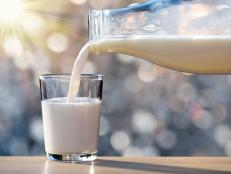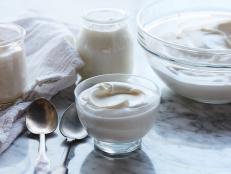Lactose Intolerance 101
Read this before you cut milk out of your life for good.

Sam Edwards/Getty Images
Does drinking milk and chowing down on pizza mean an upset stomach for the rest of the day? Lactose intolerance is one of those conditions you hear about and think you may have, but aren’t 100% sure. Many who have lactose intolerance think that avoiding all milk and dairy is the answer, but the research shows that might not be the case. Here's the deal behind lactose intolerance and how you can include milk and dairy in a lactose intolerant-friendly diet without feeling super uncomfortable.
What Is Lactose Intolerance?
Lactose intolerance is when your gastrointestinal tract has symptoms like pain, gas or diarrhea after taking in more lactose than your body can digest at that time. Usually the body breaks down lactose into its two parts called glucose and galactose, but if your body can’t get to it (because you had more than your body can handle) then that lactose goes through your digestive system undigested — which leads to all those uncomfortable symptoms.
An estimated 30-50 million Americans identify as being lactose intolerant. It is rare in children and usually begins to show up in adolescence or adulthood. Both men and women can be affected equally. It’s prevalent in an estimated 19.5% of African Americans, 10% of Hispanic Americans and 8% of European Americans.
The good news is with simple management strategies, those with lactose intolerance can enjoy milk and milk products.
How Do I Know I'm Lactose Intolerant?
Self-diagnosing lactose intolerance and then cutting out all the dairy isn’t the smartest way to go. Milk and dairy provide nine essential nutrients including several that the 2015-2020 dietary guidelines identified as being under-consumed by Americans including calcium and vitamin D. In addition, research shows that those who do keep cow’s milk dairy in their diet have a better diet quality and take in more essential nutrients. Milk and dairy are associated with a lower risk of osteoporosis (weakened and brittle bones) later in life, a lower risk of high blood pressure and a lower risk of colon cancer.
There are two tests to identify lactose intolerance. The first is the lactose tolerance test where you drink a lactose-filled beverage and blood is drawn to see if your body is breaking it down. The second is a hydrogen breath test where, again, you drink a lactose-filled beverage and then breathe into a tube to check if your body is breaking it down. Once you get diagnosed, then you can figure out how to manage your diet better!
I'm Lactose Intolerant. Now What?
An expert panel from the National Institute of Health and the National Medical Association recommends that those with lactose intolerance keep milk and dairy in their diet. Research shows that those with lactose intolerance can build up enough tolerance to be able to handle 12 grams of lactose, which is the amount found in 1 cup of milk. That doesn’t mean that you should go home and down a glass right now, but over time you can build up your tolerance so your body can handle it.
If you're going to build up a tolerance to lactose, starting with lower lactose foods is important. Milk has 12 grams of lactose, but a 1/2 cup of Greek yogurt only has 4 grams, 1 ounce of Swiss, cheddar or mozzarella has less than 0.1 grams and a 1/2 cup of cottage cheese has 3 grams. Both Greek and traditional yogurt have live, active cultures that help breakdown the lactose, and many people are able to handle those better. Some folks with lactose intolerance seem to do better on A2 milk. This milk is made from beta-casein protein A2 and is free from beta-casein protein A1 (other milks have both A1 and A2 protein in them).
Other tricks for taking in milk and dairy with lactose intolerance include:
• Combining milk and dairy with other foods: This helps slow digestion so your body can better handle the lactose. For example, make a smoothie with Greek yogurt, fruit and peanut butter or sprinkle some cheese over your cooked vegetables.
• Using lactase pills or drops: Lactase is the enzyme that helps digest the lactose sugar. You can take a pill or use droplets in your beverages to help with digestion. Read the instructions as the lead time from taking the pill to eating dairy varies between brands.
• Increase milk and dairy slowly: Don’t expect to go from eating no dairy to eating one cup a day. Build your tolerance up slowly over weeks or even months.
What About Other Foods and “Milks?”
If you think you can get the calcium you need from other foods, it’s not as easy as it sounds. For example, you would need to eat more than 10 cups of raw spinach to get the same amount of calcium in 1 cup of milk. So really, cow’s milk is a concentrated source of 9 essential nutrients that are tough to get from other sources. The closest food item, in terms of nutrition, is soy milk or soy products. The 2015-2020 dietary guidelines include soy milk in the milk and dairy category. Other milks just don’t come close nutritionally to cow’s milk – in protein, calcium and other nutrients – to be counted as a serving of dairy, but you can still enjoy them.
Bottom Line
If you think you have lactose intolerance, get tested first! Once you are diagnosed with lactose intolerance, you can then manage it using a variety of tips which do include keeping the deliciousness of dairy in your diet.
*Disclosure: I have worked as an ambassador with the National Dairy Council for about 8 years. All thoughts are my own.
Toby Amidor, MS, RD, CDN, is a registered dietitian and consultant who specializes in food safety and culinary nutrition. She is the author of The Greek Yogurt Kitchen: More Than 130 Delicious, Healthy Recipes for Every Meal of the Day.
*This article was written and/or reviewed by an independent registered dietitian nutritionist.
Related Content:


































